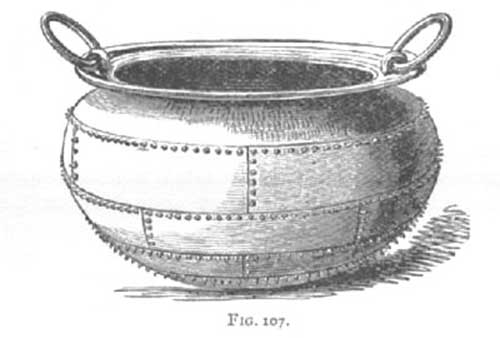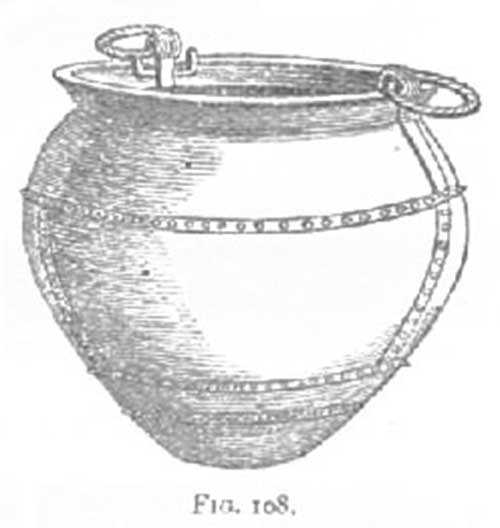Cooking
From A Smaller Social History of Ancient Ireland 1906
« previous page | contents | start of chapter | next page »
CHAPTER XVII....continued
3. Cooking.
In great houses there were professional cooks, who, while engaged in their work, wore a linen apron round them from the hips down, and a flat linen cap on the head; but among ordinary families the women did the cooking.
Meat and fish were cooked by roasting, boiling, or broiling. A spit (bir)—made of iron—was an article in general use, and was regarded as an important household implement. But the spits commonly used in roasting, as well as the skewers for trussing up the joint, were pointed hazel-rods, peeled and made smooth and white. Meat, and even fish, while roasting, were often basted with honey or with a mixture of honey and salt. Meat and fish were often broiled on a gridiron, or something in the nature of a gridiron.
When bodies of men marched through the country, either during war or on hunting excursions, they cooked their meat in a large way. Keating and other writers give the following description of how the Fena of Erin cooked—a plan which is often referred to in the ancient tales, and which was no doubt generally followed, not only by the Fena but by all large parties camping out. The attendants roasted one part on hazel spits before immense fires of wood, and baked the rest on hot stones in a pit dug in the earth. The stones were heated in the fires. At the bottom of the pit the men placed a layer of these hot stones: then a layer of meat-joints wrapped in sedge or in hay or straw ropes to keep them from being burned: next another layer of hot stones: down on that more meat: and so on till the whole was disposed of, when it was covered up; and in this manner it was effectively cooked. The remains of many of these cooking-pits are still to be seen in various parts of the country, and are easily recognised by the charred wood and blackened stones; and sometimes the very pits are to be seen. To this day they are called by an Irish name signifying "the cooking places of the Fena."
FIG. 107. Ancient Bronze Caldron 12 inches deep: formed of separate pieces, beautifully riveted, the head of each rivet forming a conical stud or button, like the rivets of the gold gorgets and of some of the bronze trumpets. (From Wilde's Catalogue).
In the house of every chief and of every brewy there was at least one bronze caldron for boiling meat. Its usual name was coire or caire [2 syll.]: but it was sometimes called aighean, or more correctly, adhan [ey-an], which is now its usual name in Scotland. It was highly valued as a most important article in the household; and it was looked upon as the special property of the chief or head of the house—much in the same way as his sword and shield. Everywhere we meet with passages reminding us of the great value set on these caldrons. One of them was regarded as a fit present for a king. The caldron of a chief or of a brewy was supposed to be kept in continual use, so that food might be always ready for guests whenever they happened to arrive. Many bronze caldrons have been found from time to time, and are now preserved in the National Museum, Dublin—several of beautiful workmanship, like those in figs. 107, 108. Caldrons appear to have been always made of brass or bronze—most often the latter. Those hitherto found are all of that material. Caldrons were manufactured at home: but some at least, and those among the most valuable, were imported.
FIG. 108. Ancient Irish bronze caldron, 12 ½ inches deep, formed of plates beautifully riveted together. Shows marks and signs of long use over a fire. (From Wilde's Catalogue).
Accompanying every caldron was an ael or flesh-fork, for lifting out pieces of meat. On one occasion, soon before the Battle of Dunbolg, A.D. 598, St. Maidoc of Ferns brought to Branduff, king of Leinster, a present of a three-pronged fleshfork (áel-trébend), a caldron, a shield, and a sword: an odd combination, quite characteristic of the times. But in early ages kitchen utensils were everywhere regarded as important. The inventory of the jewels of the English King Edward III. gives a list of this king's frying-pans, gridirons, spits, &c. There is a curious provision in the Brehon Law that if any accident occurred to a bystander by the lifting of the joint out of the boiling caldron, the attendant was liable for damages unless he gave the warning: "Take care: here goes the ael into the caldron!"


